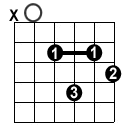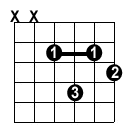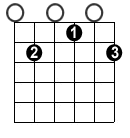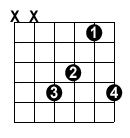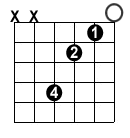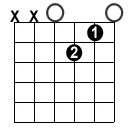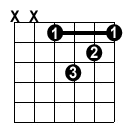9th chords are similar to 7th chords except we add the 9th scale step which is the same as the 2nd. There are 3 types of 9th chords. Dominant, major and minor. The dominant 9th chord is the most commonly used.
It’s common symbol is simply a “9”. For example: E9 is an E dominant 9th chord.
This page is dedicated to the dominant 9th chord.
Ninth chords are used heavily in blues, jazz and sometimes even in rock music.
We’ll go into their various uses a little latter on, but for now lets learn their patterns.
As with all chords, there are 5 basic 9th chord patterns. C, A, G, E, and D.
C9 Chord Pattern
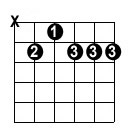
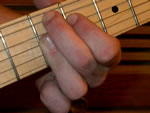
You can determine the name of the chord when the root (lowest) note is played on the frets in the chart below. There is no pattern for C9 style chord that utilizes the open strings.
| Fret | 1 | 2 | 3 | 4 | 5 | 6 | 7 | 8 | 9 | 10 | 11 | 12 |
| Chord | – | B | C | C#/Db | D | D#/Eb | E | F | F#/Gb | G | G#/Ab | A |
A9 Chord Pattern
open
barred
This movable A9 chord pattern ommits the root note (which in effect creates an inversion). You can determine the name of the chord when the lowest fretted note is played on the frets in the chart below.
| Fret | 1 | 2 | 3 | 4 | 5 | 6 | 7 | 8 | 9 | 10 | 11 | 12 |
| Chord | G#/Ab | A | A#/Bb | B | C | C#/Db | D | D#/Eb | E | F | F#/Eb | G |
G Style 9th Chord
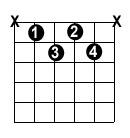
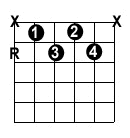
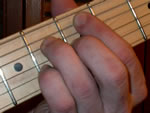
As with the A9, this movable G9 chord pattern ommits the root note (which in effect creates an inversion). You can see where the actual root note is located in the second diagram above. You can determine the name of the chord when the lowest fretted note is played on the frets in the chart below.
| Fret | 1 | 2 | 3 | 4 | 5 | 6 | 7 | 8 | 9 | 10 | 11 | 12 |
| Chord | F#/Gb | G | G#/Ab | A | A#/Bb | B | C | C#/Db | D | D#/Eb | E | F |
E Style 9th Chord
open
barred
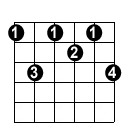
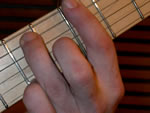
You can determine the name of the chord when the root (lowest) note is played on the frets in the chart below.
| Fret | 1 | 2 | 3 | 4 | 5 | 6 | 7 | 8 | 9 | 10 | 11 | 12 |
| Chord | F | F#/Gb | G | G#/Ab | A | A#/Bb | B | C | C#/Db | D | D#/Eb | E |
alternate E9 patterns
This pattern is an inversion. The root note is on the high E string. Use it to find the name of the chord when it appears on the frets in the chart below.
| Fret | 1 | 2 | 3 | 4 | 5 | 6 | 7 | 8 | 9 | 10 | 11 | 12 |
| Chord | – | – | G | G#/Ab | A | A#/Bb | B | C | C#/Db | D | D#/Eb | E |
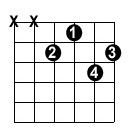
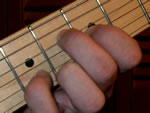
You can determine the name of the chord when the root (lowest) note is played on the frets in the chart below.
| Fret | 1 | 2 | 3 | 4 | 5 | 6 | 7 | 8 | 9 | 10 | 11 | 12 |
| Chord | D#/Eb | E | F | F#/Gb | G | G#/Ab | A | A#/Bb | B | C | C#/Db | D |
D Style 9th Chord
open patterns
This variation on the pattern actually omits the major 3rd.
barred
You can determine the name of the chord when the root (lowest) note is played on the frets in the chart below.
| Fret | 1 | 2 | 3 | 4 | 5 | 6 | 7 | 8 | 9 | 10 | 11 | 12 |
| Chord | D#/Eb | E | F | F#/Gb | G | G#/Ab | A | A#/Bb | B | C | C#/Db | D |
